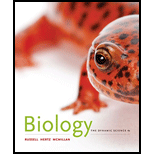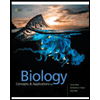
Concept explainers
In an
meiosis within the male gametophyte to produce sperm.
meiosis within the female gametophyte to produce eggs.
meiosis within the ovary to produce megaspores.
fertilization leading to development of microspores.
fertilization leading to development of megaspores.
Introduction:
The vascular seed plants that have an ovule, which on fertilization forms a seed, are angiosperms. The seed formed is enclosed within the ovary (hollow), which itself is enclosed within the flower. These are also called flowering plants and are known to have most diversity within the Plantae kingdom.
Answer to Problem 1TYK
Correct answer:
The process of meiosis takes place within the ovary to form megaspores in sexual reproduction in an angiosperm life cycle.
Explanation of Solution
Justification/ Explanation for the correct answer:
Option (c) is given as meiosis within ovary to produce megaspore. The production of haploid megaspores takes place within the ovary. The spores that are formed within the ovary help in the development of female gametophyte. These female gametophytes then undergo mitosis to form gametes that fertilize with the male gamete to form an embryo. Hence, option (c) is correct.
Explanation for the incorrect answers:
Option (a) is given as: meiosis within the male gametophyte to produce sperm. The meiosis taking place within the male gametophyte results in the development of spores, microspores. These spores then divide by mitosis to form male gametes. So, it is incorrect.
Option (b) is given as: meiosis within the female gametophyte to produce eggs. When meiosis takes place within the ovary, haploid megaspores are formed. These megaspores then form the female gametophyte by mitosis, which then produces gametes (egg). So, it is incorrect.
Option (d) is given as: fertilization leading to the development of microspores. The microspores are male spores that are formed when male gametophyte undergo meiosis. The fertilization of male and female gametes results in the formation of an embryo. So, it is incorrect.
Option (e) is given as: fertilization leading to the development of megaspores. The megaspores are formed when the female gametophyte undergoes meiosis. These megaspores form the gametes that fertilize with male gametes to form an embryo. So, it is incorrect.
Hence, options (a), (b), (d), and (e) are incorrect.
Therefore, it can be concluded that the female gametophyte present within the ovary undergoes meiosis to form megaspores. These megaspores divide by mitosis and form female gametes. Similarly, microspores are produced by the male gametophyte by meiosis, which divides by mitosis and forms male gametes. These two gametes fertilize to form the seed or the embryo.
Want to see more full solutions like this?
Chapter 36 Solutions
Biology: The Dynamic Science (MindTap Course List)
- In flowers, the structures that produce male gametophytes are called _______ ;the strcutures that produce female gametophytes are called _______ . a. pollen grains; flowers c. anthers; stigma b. stamen; carpels d. megaspores; microsporesarrow_forwardFigure 25.24 Which of the following statements about the fern life cycle is false? Sporangia produce haploid spores. The sporophyte grows from a gametophyte The sporophyte is diploid and the gametophyte is haploid. Sporangia form on the underside of the gametophyte.arrow_forwardThe three main parts of a typical mature eudicot seed are the _______ . a. pollen grain, egg, and seed coat b. embryo, endosperm, and seed coat c. megaspores, microspores, and ovule d. embryo, cotyledons, and seed coatarrow_forward
- What do gymnosperms and angiosperms have in common? Answers: They are found in all habitats. They produce flowers. They produce fruits. They have leaves with a large surface area. They reproduce with seeds. Please explain which one is the correct answer.arrow_forwardRelate the structure of an angiosperm leaf to each of the following:- Adaptations for photosynthesis and food storage.- Adaptations for food translocation and water transport.- Specialized adaptations to a desert environment.arrow_forwardIn angiosperms, after fertilization, the triploid cell gives rise to ____. a fertilized ovule a seed an embryo sporophyte endosperm a pollen grainarrow_forward
- In the lifecycle of an angiosperm, male pollen is produced in the ______ and is transferred to the ______on a carpel through the process of pollination (fill in the blanks) Group of answer choices Anther, Stigma Stamen, Petal Anther, Sepal Stamen, Receptacle Anther, Receptaclearrow_forwardIn a typical angiosperm, what is the sequence of structures encountered by the tip of a growing pollen tube on its way to the egg? ovary → style → stigma stigma → style → ovary ovary→ stigma→ style stigma→ ovary → stylearrow_forwardIn seed-bearing plants, the _______________ develops into the seed following fertilization The microsporangium. The sporophyte. The endosperm. The ovule. The pollen grain.arrow_forward
- Sketch a seed of a gymnosperm and of a monocot. Label the embryo, seed coat, and nutritive tissue (giving its specific name). Indicate the ploidy of each structure (haploid, diploid, or triploid).arrow_forwardWhich of the following is NOT part of the male reproductive parts of a flower? Anthers Sperm cells Microspores Ovule Pollenarrow_forwardGametophytes of ____ plants form protected inside reproductive parts on a sporophyte body. nonvascular seed nonvascular seedless vascular seed vascular seedless allarrow_forward
 Biology: The Dynamic Science (MindTap Course List)BiologyISBN:9781305389892Author:Peter J. Russell, Paul E. Hertz, Beverly McMillanPublisher:Cengage Learning
Biology: The Dynamic Science (MindTap Course List)BiologyISBN:9781305389892Author:Peter J. Russell, Paul E. Hertz, Beverly McMillanPublisher:Cengage Learning
 Biology 2eBiologyISBN:9781947172517Author:Matthew Douglas, Jung Choi, Mary Ann ClarkPublisher:OpenStax
Biology 2eBiologyISBN:9781947172517Author:Matthew Douglas, Jung Choi, Mary Ann ClarkPublisher:OpenStax


